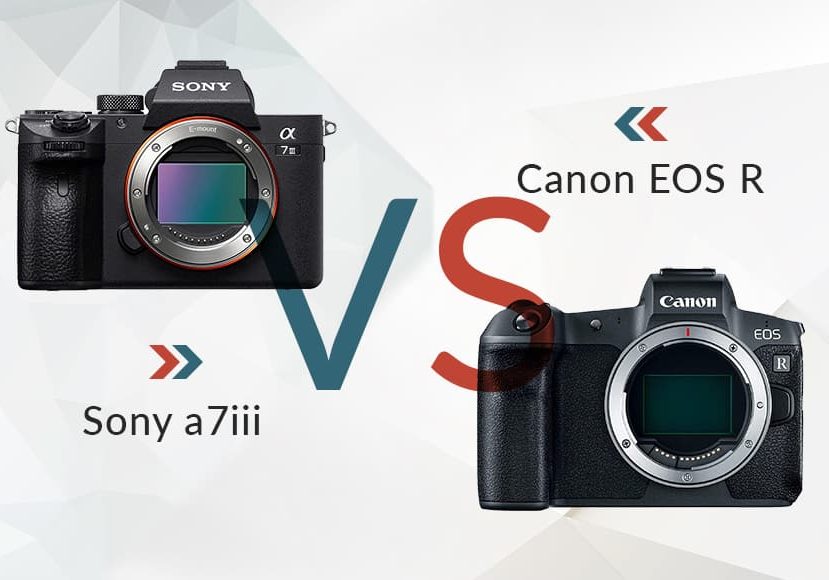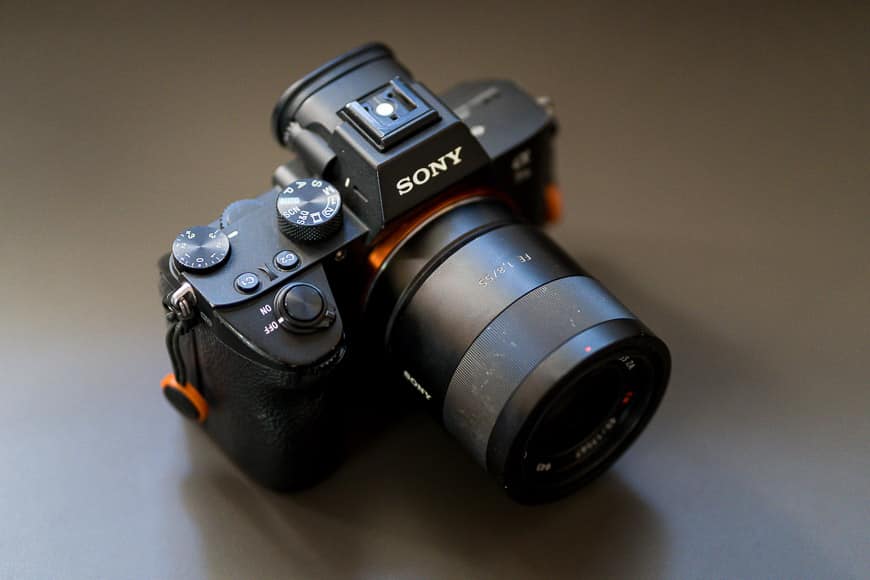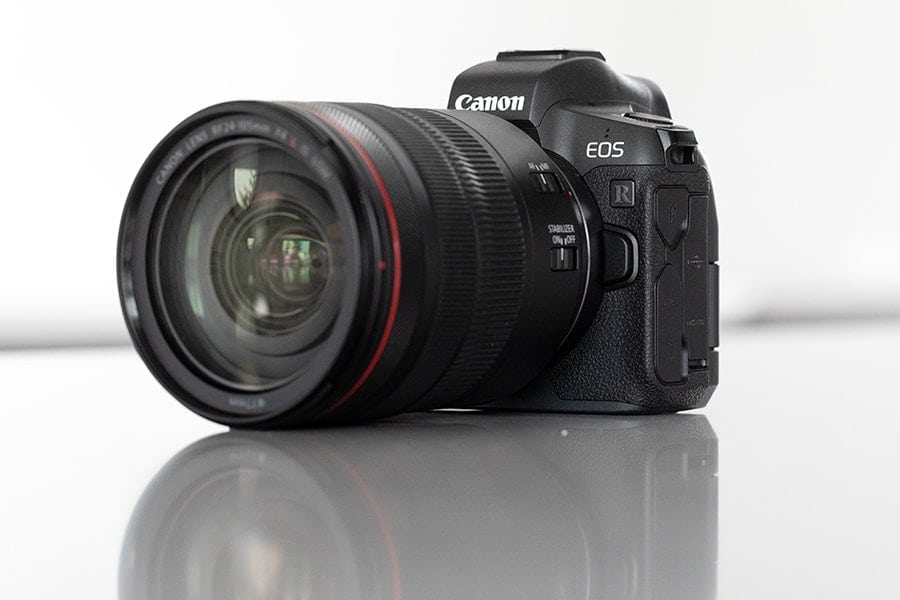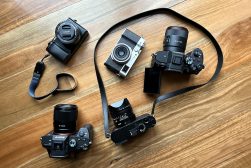
Canon EOS R vs Sony a7iii Camera Comparison
The Canon EOS R and Sony a7 iii are both incredible full frame mirrorless cameras... but which one is best? Check out our comparison to find out!
We take the guesswork out of helping you choose your next full-frame mirrorless format camera in this Canon EOS R vs Sony a7 iii critical review.
If you’re in the market for a reasonably priced mirrorless camera you may have noticed the competition is tough!
Close competition in mirrorless full-frame cameras is great news for buyers because each brand is competing with others for market share so manufacturers are jamming incredible technology into each iteration.
That’s a huge win for you as a buyer!

Superior video capability, longer battery life and inbuilt image stabilization put the Sony a7 III in the lead.
Though the EOS R and a7iii are not the latest touchscreen mirrorless cameras released – they are plenty powerful and closely matched on most technical features.
We’ll highlight the crucial differences for you below to help you make your decision much easier!
For now, let’s see if Canon or the Sony full-frame mirrorless system emerge victorious in this comparison.
Table of Contents
Sony a7 iii vs Canon EOS R | Key Differences
The Canon EOS R was Canon’s first foray into full frame mirrorless cameras.
1. Viewfinder
One of the most interesting moments of buying a mirrorless full-frame or any camera is what happens when you put your eye to the viewfinder for the first time. You’re either amazed or let down – it’s always one or the other, isn’t it?
Raising the Sony a7 iii to your eye and taking in the scene in front of you is probably not going to fill you with awe, to be honest – the electronic facsimile of the view is disappointing as almost all mirrorless cameras are. If the Sony was all you had to look at, you’d eventually agree that the viewfinder was functional and satisfactory.
The Sony camera obviously doesn’t have the wow-factor and the quality of the viewfinder isn’t good enough to make you reach into your pocket to grab two thousand dollars cash to pay for it until you really evaluate whether it is the best camera for your money.
On the other hand, looking through the dreamlike viewfinder on the Canon EOS R will tickle your brain a bit and have you giggling inside, especially if you are looking at it after you’ve already seen what Sony has to offer.
All the adjustments you’ve made in-camera to color, white balance, contrast, distortion, highlights, and shadows are seen live just as in the final photo.
That’s comforting to see live in such crystal clear detail!
But wait, don’t run out and buy the Canon yet! There’s more to know, a lot more to know in order to come to a reasonable conclusion about which system is better for your needs.
WINNER: Canon EOS R
2. Rear LCD Screen
The Sony a7 iii and the Canon EOS R both have articulating rear LCD touch screens, but the differences between them are considerable.
If you’ve had a Sony mirrorless before, you’ll probably find the a7 iii’s 3″ touch screen with 921,600 DPI to be satisfactory, and you may even think it’s fantastic – that is until you see Canon’s rear LCD!
Canon’s 3.2″ LCD with 2,100,000 DPI blows Sony’s screen away in size and resolution, and it doesn’t stop there.
The Canon has a fully-articulating screen giving you hundreds of angles to compose your shots from, and even offering a full 180° forward-facing option ideal for selfie photography and vlogging – while Sony’s a7 iii offers only the tilting screen option popular on so many digital cameras these days.
Having used fully-articulating LCD touch screens over the past six years, we’ve grown fond of them! Any camera without one necessitates the purchase of a third-party screen or another cumbersome camera accessory which adds to your shopping list.
OK, I know, two wins for the Canon already. Please hold on, don’t rush out the door to the store, just take a breath and steady yourself – you’ll thank me in a few minutes!
3. Video
In today’s world, even professional photographers shoot some video to go along with their photos. Both the Sony and Canon offer good 4K video for the web but with some marked differences.
If you’re not concerned so much about video quality, either camera will produce decent results from their full frame sensors.
The one major issue is that the Canon camera is hostage to a 1.8x crop factor which means a 30mm lens which looks great for simple landscape shots will be effectively 54mm with the sensor crop.
Getting very wide landscape shots for your EOS R video is going to necessitate wider lenses – which means spending more money!
In contrast, Sony oversamples 6K capture and downsamples to get 4K video at 24p and from 5K resolution with a 1.2x crop to give you 4K video at 30p. Sony’s video resolution is professional-grade and levels above Canon’s video results.
Another point worth mentioning is that the a7 iii has little rolling shutter problems except when it comes to fast movements, which all digital cameras have trouble with.
Canon’s EOS R has significant issues with rolling shutter – a real emphasis on slow panning is necessary while shooting. See also: What causes rolling shutter?
4. Sensor and Processor
The Canon EOS R has a higher resolution 30.3mp full frame CMOS sensor (36x24mm) with DIGIC 8 processor which is the same size as Sony’s a7 iii 24.2mp full-frame Exmor R CMOS sensor (35.6×23.8mm) with BIONZ X processor. Both sensors include a low pass filter.
The question is – does the higher resolution of the Canon camera matter in this comparison when the full frame sensor size is the same?
The answer is – not much!
Side-by-side comparisons of JPG photos from each camera shows very little difference, with the edge given to the Sony a7 iii.
A comparison of RAW files shows both systems can record scenes in intricate detail and can be easily enhanced in post-processing to very high standards, resulting in professional quality images.
A quick check online found that Dxomark rated the Sony a7 iii better than the Canon EOS R in dynamic range, tonal range, color sensitivity, color depth, and low-light ISO.
5. Battery Life
Battery life is a feature you either care intensely about, or you don’t care at all and you just buy more batteries!
While we are in the latter camp, it can cost hundreds of dollars more to outfit one camera vs the other and most people do care.
Canon’s EOS R full frame camera uses the LP-E6N lithium-ion battery which puts out 1865mAh and is good for 310 shots on a single charge.
Sony’s a7 iii cranks out 2280mAh which they rate as good for 710 shots per charge.
Sure, the Sony camera’s battery capacity is more than 22% bigger, but another couple of factors play into this.
Apparently, the bigger and more detailed LCD touch screen and viewfinder on the Canon deplete the battery far faster than on the Sony camera.
6. Image Stabilization
You’ve either got it, or you don’t! Canon doesn’t have it and Sony’s a7 iii does.
Sony’s a7 iii has the advantage of this feature over Canon simply because they have in-camera sensor-based 5-axis optical stabilization.
All lenses attached to the a7 iii will produce stabilized images with up to 5-stops of stabilization – this is a great feature for a full frame camera to have – check out our Sony a7III lens reviews for more info.
Yes, some videographers will always choose to use a camera gimbal over any in-camera stabilization, but shooting at 1/15th of a second hand-held with no external stabilizer is a wonderful experience!
7. Drive (FPS)
One small difference between these two cameras is the drive speed (frame rate) is slightly different. The a7 iii is capable of grabbing 10 frames per second (fps) and Canon’s EOS R shoots 8 fps.
If you work in the sports or wildlife photography industry, you might be familiar with the phrase, ‘spray and pray.’ Holding the shutter down and shooting hundreds of photos per minute can yield great shots that you wouldn’t get otherwise.
If you’re shooting for three hours each day over a weekend, you might spray and pray 80 times for 3-seconds at a time. Doing this with the Canon EOS R you’ll get 1,920 images and with the Sony, you’ll get 2,400 – that’s 480 more images!
If getting more shots in a short time is crucial to your business success, the Sony a7 iii is your only choice here.
8. Ergonomics/Handling
How a camera feels in your hands is rather subjective, and a lot of it comes down to the size of your hands and what you’re used to using in the past.
The Sony a7 iii body is smaller and lighter than the Canon EOS R, which will please those who prefer a more compact system for daily use or travel, that still offers the power and flexibility of a full frame sensor.
However, on the flip side, the Canon EOS R is a lot more comfortable to hold, especially for long periods when the Sony’s body starts to feel a little awkward and cramped.
The grip on the Canon is also deeper, which equates to a more comfortable and safe grip on your camera body, especially when using longer (and heavier) lenses.
One small quirk is the angled shutter button on the EOS R, which some users may find a little odd… at least initially, but then it becomes quickly forgotten.
Overall, it’s another win to Canon in the ergonomics/handling department though. The EOS R is a mirrorless camera that actually feels more like its DSLR predecessors, while still featuring all the modern tech of the new generation of bodies.
WINNER: Canon EOS R
9. Autofocus
Snappy autofocus which locks on to your subject and doesn’t let go is an essential feature, particularly on these high-spec camera models designed for professional use.
You have to feel a little sorry for the Canon EOS R in this department – the autofocus isn’t bad, per se, but it isn’t wow-inducing either. It’s pretty much the same as the 5D Mark IV, which is a shame really since we were all expecting a lot more.
The Sony a7 iii on the other hand is another story entirely. Sony has long been the leader in the autofocus stakes, and with the a7 iii’s incredibly Eye-af and real time tracking, the cross hair in your viewfinder is pretty much glued to your subject’s eye in a millisecond… and doesn’t let go until you take the shot.
Thanks to firmware updates, Sony brings even more to the table with features such as eye-tracking for animals (!), all free to download straight to the a7 iii. Canon is doing something similar with its own set of firmware updates, but we can’t help feeling that they have a lot of catching up to do.
Long story short – the a7 iii is leagues ahead of the EOS R with autofocus, both in decent light and low light conditions. If your work depends on getting the shot in a split second, the choice here is a clear one.
10. Price
Currently, the Canon EOS R is around $200 cheaper than the Sony a7 iii (check the latest prices by clicking on any of the links in this guide).
However, when purchasing a new full frame camera body, it’s important to look at the price of peripheral products too – most notably, the cost of lenses.
With Canon and Sony, there’s not a whole lot of difference in the price of lenses across the board, but one big thing in Canon’s favour is the wide range of lenses available – Canon offers several ‘budget’ lenses, (including a nifty-fifty for under $100), but Sony’s most affordable full frame lens costs twice this.
However, as you’ll have seen in this Canon EOS R vs Sony a7iii comparison, the Sony does offer more for the money, so it’d be unfair to simply say that as the Canon is simply cheaper, it’s a better choice. We’re going to call this one a tie!
Frequently Asked Questions
What’s better Canon or Sony?
Both Canon and Sony are fierce competitors. Most people consider Sony the mirrorless full-frame company to beat, but Canon offer a wider selection of lenses.
Is the Canon EOS R good for video?
If your video needs are not professional quality and you can live with the 1.8x crop factor, and poor rolling-shutter results then yes, you can get good but not great video for the web from your Canon EOS R.
Is the Canon EOS R weather sealed?
Yes, the Canon body is weather-sealed (environmentally sealed) and can resist light rain and humid conditions to some degree. Do keep in mind that lenses are often not weather-sealed and can let in air, dust, and water thereby undermining the ability of the Canon body to stay dry inside.
Can the Sony a7 use Canon lenses?
Yes, you can use Canon lenses on the Sony a7 series mirrorless with an adapter. Results show autofocus accuracy typically suffers using these adapters and lenses and shows manual focusing works much better than using autofocus.
Canon EOS R versus Sony a7 iii | Final Words

The Sony a7 iii is still our favourite when it comes to comparing it to the EOS R.
The Sony is a well-made camera which has persuaded many photographers to drop their DSLR systems for the smaller mirrorless full-frame format. Every year the differences between the two systems are harder to see!
Highlights of the Sony a7 III include the in-camera 5-axis optical image stabilization and 693 autofocus points covering 93% of the frame. Sony has improved its autofocus speed as well and claims a nearly 2x speed increase over the previous a7 ii model.
Other positives include exceptional 4K video resolution and use of the sensor’s full-frame capture to downsample, resulting in super-crisp 4K video resolution which is more than adequate for professional use.
When this camera was first released it was met with rave reviews and quickly became the gold standard upon which all other full-frame mirrorless cameras are judged. Not that much has changed in two years and it is still a reliable workhorse with excellent speed in low-light for sports, has exceptional autofocus, and a wide dynamic range for landscapes.
If you also shoot video, this Sony a7 iii is the reasonably priced system for you!
The Canon EOS R isn’t a bad full-frame mirrorless camera, it’s just unfortunate that it is going up against a great camera, the Sony a7 iii in this review!
Though the Canon EOS R didn’t fare too well in this Sony vs Canon comparison, the EOS R is quite adequate for most people’s needs. If you’re a professional, you’ll opt for the Sony, if not, you might be swayed by Canon’s attention to detail in the LCD screen and viewfinder – both of which are better than Sony’s a7 iii.
You may like the Canon menu system, as we prefer the Nikon style over Canon in our DSLR system. The Canon EOS R is a very capable camera that also receives rave reviews.
Another factor to keep in mind is that when travelling internationally it may be easier to find a service shop for your Canon system than for your Sony gear.
Whichever you choose, keep in mind that Sony has been focused on these smaller systems for longer than Canon and they have optimized their camera bodies, buttons, menus, and focused on a feature-set that appeals to pros and other consumers alike.
Sony is on top of the mirrorless world at the moment and it doesn’t look like there will be anyone to contend with them seriously for the next couple of years.
(If you need to delve deeper, check out our full Sony a7iii Review and Canon EOS R Review. For comparisons, there’s our Sony a7ii vs a7 iii comparison and a detailed Nikon Z6 vs Sony a7 III one too.)

Superior video capability, longer battery life and inbuilt image stabilization put the Sony a7 III in the lead.














